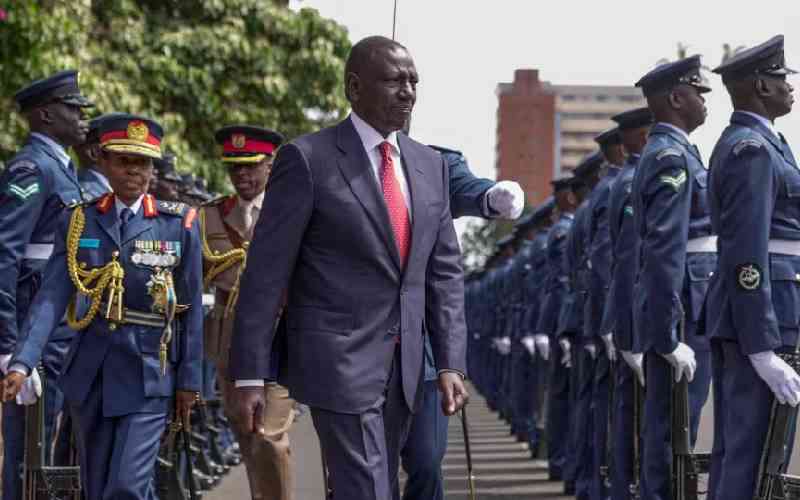NAIROBI: “If we approve a lower figure, we’ll have to come back and ask for more. So we thought, why not have enough until 2017?” Cabinet Secretary, Henry Rotich.
It all started on December 9, 2014. The Government’s borrowing limit from external sources was Sh1.2 trillion. Government required the approval of Parliament to increase this borrowing limit. The Government intended to increase this limit to Sh2.4 trillion.
Though the National Assembly has 349 Members of Parliament, on that historic day there were only 122 members present. The other 227 members were absent.
The Cabinet Secretary is quoted in the press as giving at least two reasons for the request to double the borrowing limits at one sitting of Parliament. He said the Government needed this funding to finance infrastructure projects.
He also said it was inconveniencing for the Government to keep returning to Parliament every time it needed a further increase in the external borrowing limit. By approving the increase in the limit at only one sitting the Government would not require to go back to Parliament for further approval until 2017.
It was December 9, 2014 that marked the beginning of the free fall of Kenya’s economy. This is the day that 65 per cent of members, for whatever reason, stayed away, leaving 35 per cent of the House to debate and vote on the Government’s request.
Only 349 members, on behalf of 45 million Kenyans, could ask the hard questions of Government. One, was convenience a valid reason to increase the debt ceiling at a go? Two, what would be the long term and short term benefits of the infrastructure projects that required external financing? Three, how would the borrowing be staggered between December 2014 and August 2017? Four, what would be the long term and short term effects on the economy? Five, will Government continue borrowing from the domestic market?
On that day, December 9, 2014, only 122 members turned up. Only 42 voted against the request. One member abstained from voting, the remaining 79 voted in favour of the Government’s request.
Eleven months later, the results of the Government’s borrowing spree are there for all to see. Everyone, including Members of Parliament, has been affected by the falling shilling, government cash crunch, rising interest rates and the teetering economy.
On June 30, 2015 our external debt was Sh1.423 trillion. Thanks to Parliament, Government can unilaterally increase this by another Sh 1 trillion.
On June 30, 2015 the Government’s domestic debt was Sh1.420.4 trillion. Through M-Akiba, the Government is planning to borrow more from the domestic market, despite promising not to do so when it floated the Euro-Bond and when it increased the external borrowing limit ceiling.
Between July 2014 and June 2015 the Government’s recurrent expenditure was Sh840 million. Thirty per cent of this expenditure was spent on public wages and salaries. Twenty per cent of this expenditure was spent on repayments of public debt. In the same period, while the public wage bill grew by 4.2 per cent the Government’s repayments of public debt grew by 152.8 per cent
Government is still borrowing more. From external sources and the domestic market. As a result, interest rates are sky-rocketing. Commodity prices rise every week. Teachers can’t be paid more. Civil servants will be retrenched.
Private businesses can’t raise working capital through borrowing. Private businesses with existing loan facilities will have to downsize both their production and labour force. Homeowners with mortgages will have less income, or worse still lose their homes. Under our Constitution, Parliament is the public watchdog of Kenya’s finances. It failed on December 9, 2014. When will the 349 members rise to the occasion and come to the rescue of Kenya and Kenyans?
 The Standard Group Plc is a
multi-media organization with investments in media platforms spanning newspaper
print operations, television, radio broadcasting, digital and online services. The
Standard Group is recognized as a leading multi-media house in Kenya with a key
influence in matters of national and international interest.
The Standard Group Plc is a
multi-media organization with investments in media platforms spanning newspaper
print operations, television, radio broadcasting, digital and online services. The
Standard Group is recognized as a leading multi-media house in Kenya with a key
influence in matters of national and international interest.
 The Standard Group Plc is a
multi-media organization with investments in media platforms spanning newspaper
print operations, television, radio broadcasting, digital and online services. The
Standard Group is recognized as a leading multi-media house in Kenya with a key
influence in matters of national and international interest.
The Standard Group Plc is a
multi-media organization with investments in media platforms spanning newspaper
print operations, television, radio broadcasting, digital and online services. The
Standard Group is recognized as a leading multi-media house in Kenya with a key
influence in matters of national and international interest.






